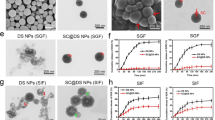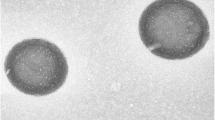Abstract
In the past decades, many materials have been studied as carriers for targeted drug delivery. However, there is a need for utilizable and selective carrier materials with few side effects. Here, the magnetic Ganoderma Lucidum Spores (mGLS) as a highly efficient targeted drug delivery carrier were explored. Then the regulatable targeted drug delivery system was verified by loading and releasing of the 5-Fluorouracil (5-FU). The results showed that the maximum of the loaded 5-FU reached 250.23 mg·g−1 in the mGLS. The cumulative release of the 5-FU for the drug delivery system could reach 80.11% and 67.14% in the PBS and HCl after 48 h, respectively. In addition, this system showed the good pharmacokinetic properties in vivo. After 12 h, the blood concentration in the 5-FU@mGLS group kept at 5.3 µg·mL−1 and was four times higher than that in the 5-FU group. In summary, the GLS as a natural microscale core-shell structures appears the striking application in carrier material for oral drug delivery.
Similar content being viewed by others
References
Assa F, Jafarizadeh-Malmiri H, Ajamein H, Vaghari H, Anarjan N, Ahmadi O, Berenjian A. Chitosan magnetic nanoparticles for drug delivery systems. Critical Reviews in Biotechnology, 2017, 37, 492–509.
Zhang Y X, Xiang J F, Liu Y, Zhang X F, Tang Y L. Constructing transferrin receptor targeted drug delivery system by using doxorubicin hydrochloride and vanadocene dichloride. Bioorganic & Medicinal Chemistry Letters, 2011, 21, 5982–5986.
Paolino D, Cosco D, Cilurzo F, Fresta M. Innovative drug delivery systems for the administration of natural compounds. Current Bioactive Compounds, 2007, 3, 262–277.
Leong K W, Brott B C, Langer R. Bioerodible polyanhydrides as drug — carrier matrices. I: characterization, degradation, and release characteristics. Journal of Biomedical Materials Research, 1985, 19, 941–955.
Torchilin V P. Targeting of drugs and drug carriers within the cardiovascular system. Advanced Drug Delivery Reviews, 1995, 17, 75–101.
Nishikawa M, Hashida M. Pharmacokinetics of anticancer drugs, plasmid DNA, and their delivery systems in tissue-isolated perfused tumors. Advanced Drug Delivery Reviews, 1999, 40, 19–37.
Song Y H, Li Y H, Xu Q, Liu Z. Mesoporous silica nanoparticles for stimuli-responsive controlled drug delivery: Advances, challenges, and outlook. International Journal of Nanomedicine, 2016, 12, 87–110.
Zhu Y, Li J, Li W X, Zhang Y, Yang X F, Chen N, Sun Y H, Zhao Y, Fan C H, Huang Q. The biocompatibility of nanodiamonds and their application in drug delivery systems. Theranostics, 2012, 2, 302–312.
Vaizoglu O, Speiser P. Intelligent drug delivery systems. Trends in Pharmacological Science, 1982, 3, 28–30.
Wilczewska A Z, Niemirowicz K, Markiewicz K H, Car H. Nanoparticles as drug delivery systems. Pharmacological Reports, 2012, 64, 1020–1037.
Goudoulas T B. Polymers and biopolymers as drug delivery systems in nanomedicine. Recent Patents on Nanomedicine, 2012, 2, 52–61.
Zhou Z J, Shen Z Y, Chen X Y. Tale of two magnets: An advanced magnetic targeting system. ACS Nano, 2020, 14, 7–11.
Le T A, Bui M P, Yoon J W. Electromagnetic actuation system for focused capturing of magnetic particles with a half of static saddle potential energy configuration. IEEE Transactions on Biomedical Engineering, 2021, 68, 869–880.
Li L L, Chen D, Zhang Y Q, Deng Z T, Ren X L, Meng X W, Tang F Q, Ren J, Zhang L. Magnetic and fluorescent multifunctional chitosan nanoparticles as a smart drug delivery system. Nanotechnology, 2007, 18, 405102.
Yallapu M M, Othman S F, Curtis E T, Gupta B K, Jaggi M, Chauhan S C. Multi-functional magnetic nanoparticles for magnetic resonance imaging and cancer therapy. Biomaterials, 2011, 32, 1890–1905.
Chertok B, Moffat B A, David A E, Yu F Q, Bergemann C, Ross B D, Yang V C. Iron oxide nanoparticles as a drug delivery vehicle for MRI monitored magnetic targeting of brain tumors. Biomaterials, 2008, 29, 487–496.
Chen F H, Zhang L M, Chen Q T, Zhang Y, Zhang Z J. Synthesis of a novel magnetic drug delivery system composed of doxorubicin-conjugated Fe3O4 nanoparticle cores and a PEG-functionalized porous silica shell. Chemical Communications, 2010, 46, 8633–8635.
Madani M, Sharifi-Sanjani N, Faride-Majidi R. Magnetic polystyrene nanocapsules with core-shell morphology obtained by emulsifier-free miniemulsion polymerization. Polymer Science Series A, 2011, 53, 143–148.
Urbina M C, Zinoveva S, Miller T, Sabliov C M, Monroe W T, Kumar C S S R. Investigation of magnetic nanoparticle-polymer composites for multiple-controlled drug delivery. Journal of Physical Chemistry C, 2008, 112, 11102–11108.
He Q, Tian Y, Cui Y, Moehwald H, Li J B. Layer-by-layer assembly of magnetic polypeptide nanotubes as a DNA carrier. Journal of Materials Chemistry, 2008, 18, 748–754.
Cui M, Wang F J, Shao Z Q, Lu F S, Wang W J. Influence of DS of CMC on morphology and performance of magnetic microcapsules. Cellulose, 2011, 18, 1265–1271.
Alshehri S M, Al-Lohedan H A, Al-Farraj E, Alhokbany N, Chaudhary A A, Ahamad T. Macroporous natural capsules extracted from Phoenix dactylifera L. spore and their application in oral drugs delivery. International Journal of Pharmaceutics, 2016, 504, 39–47.
Paunov V N, Mackenzie G, Stoyanov S D. Sporopollenin micro-reactors for in-situ preparation, encapsulation and targeted delivery of active components. Journal of Materials Chemistry, 2007, 17, 609–612.
Arizumi T, Toriyama K. Genetic regulation of sporopollenin synthesis and pollen exine development. Annual Review of Plant Biology, 2011, 62, 437–460.
Mundargi R C, Potroz M G, Park S, Park J H, Shirahama H, Lee J H, Seo J, Cho N J. Lycopodium spores: A naturally manufactured, superrobust biomaterial for drug delivery. Advanced Functional Materials, 2016, 26, 487–497.
Li S Y, Nguyen L, Xiong H R, Wang M Y, Hu T C C, She J X, Serkiz S M, Wicks G G, Dynan W S. Porous-wall hollow glass microspheres as novel potential nanocarriers for biomedical applications. Nanomedicine, 2010, 6, 127–136.
Lin Z B. Modern Research of Ganoderma lucidum, 2nd ed, Beijing Medical University Press, Beijing, China, 2007.
Zhao D, Chang M W, Li J S, Suen W, Huang J. Investigation of ice-assisted sonication on the microstructure and chemical quality of Ganoderma lucidum spores. Journal of Food Science, 2014, 79, E2253–E2265.
Mundargi R C, Tan E L, Seo J, Cho N J. Encapsulation and controlled release formulations of 5-fluorouracil from natural Lycopodium clavatum spores. Journal of Industrial Engineering Chemistry, 2016, 36, 102–108.
Wang J X, Zhou G Q, Chen C Y, Yu H W, Wang T C, Ma Y M, Jia G, Gao Y X, Li B, Sun J, Li Y F, Jiao F, Zhao Y L, Chai Z F. Acute toxicity and biodistribution of different sized titanium dioxide particles in mice after oral administration. Toxicology Letters, 2007, 168, 176–185.
Blackmore S, Knox R B. Microspores Evolution and Ontogeny, Academic Press, London, England, 1990.
Barrier S, Rigby A S, Diego-Taboada A, Thomasson M J, Mackenzie G, Atkin S L. Sporopollenin exines: A novel natural taste masking material. LWT-Food Science and Technology, 2010, 43, 73–76.
Barrier S, Diego-Taboada A, Thomasson M J, Madden L, Pointon J C, Wadhawan J D, Beckett S T, Atkin S L, Mackenzie G. Viability of plant spore exine capsules for microencapsulation. Journal of Materials Chemistry, 2011, 21, 975–981.
Thio B J R, Clark K K, Keller A A. Magnetic pollen grains as sorbents for facile removal of organic pollutants in aqueous media. Journal of Hazardous Materials, 2011, 194, 53–61.
Fan L L, Wang Y, Zhao M, Song J Z, Wang J Y, Jin Z J. Magnetic Ganoderma lucidum spore microspheres: A novel material to immobilize CotA multicopper oxidase for dye decolorization. Journal of Hazardous Materials, 2016, 313, 122–129.
Nigam S, Barick K C, Bahadur D. Development of citrate-stabilized Fe3O4 nanoparticles: Conjugation and release of doxorubicin for therapeutic applications. Journal of Magnetism and Magnetic Materials, 2011, 323, 237–243.
Zhou H J, Lee J, Park T J, Lee S J, Park J Y, Lee J. Ultrasensitive DNA monitoring by Au-Fe3O4 nanocomplex. Sensors and Actuators B: Chemical, 2012, 163, 224–232.
Zhang Y B, Zhang L, Yang L D, Vong C L, Chan K F, Wu W K K, Kwong T N Y, Lo N W S, Ip M, Wong S H, Sung J J Y, Chiu P W Y, Zhang L. Real-time tracking of fluorescent magnetic spore-based microrobots for remote detection of C. diff toxins. Science Advances, 2019, 5, eaau9650.
Mogharabi M, Nassiri-Koopaei N, Bozorgi-Koushalshahi M, Nafissi-Varcheh N, Bagherzade G, Faramarzi M A. Immobilization of laccase in alginate-gelatin mixed gel and decolorization of synthetic dyes. Bioinorganic Chemistry and Applications, 2012, 2012, 823830.
Qiu H J, Xu C X, Huang X R, Ding Y, Qu Y B, Gao P J. Immobilization of laccase on nanoporous gold: Comparative studies on the immobilization strategies and the particle size effects. Journal of Physical Chemistry C, 2009, 113, 2521–2525.
Zheng X B, Wang Q, Jiang Y J, Gao J. Biomimetic synthesis of magnetic composite particles for laccase immobilization. Industrial & Engineering Chemistry Research, 2012, 51, 10140–10146.
Nagarwal R C, Singh P N, Kant S, Maiti P, Pandit J K. Chitosan nanoparticles of 5-fluorouracil for ophthalmic delivery: Characterization, in-vitro and in-vivo study. Chemical & Pharmaceutical Bulletin, 2011, 59, 272–278.
Longley D B, Harkin D P, Johnston P G. 5-fluorouracil: mechanisms of action and clinical strategies. Nature Reviews Cancer, 2003, 3, 330–338.
Pardini B, Kumar R, Naccarati A, Novotny J, Prasad R B, Forsti A, Hemminki K, Vodicka P, Bermejo J L. 5-Fluorouracil-based chemotherapy for colorectal cancer and MTHFR/MTRR genotypes. British Journal of Clinical Pharmacology, 2011, 72, 162–163.
Mühlen A Z, Schwarz C, Mehnert W. Solid lipid nanoparticles (SLN) for controlled drug delivery-drug release and release mechanism. European Journal of Pharmaceutics and Biopharmaceutics, 1998, 45, 149–155.
Zhang J H, Lin X N, Liu J J, Zhao J Q, Dong H X, Deng L D, Liu J F, Dong A J. Sequential thermo-induced self-gelation and acid-triggered self-release process of drug-conjugated nanoparticles: A strategy for the sustained and controlled drug delivery to tumors. Journal of Materials Chemistry B, 2013, 1, 4667–4677.
Hu X Y, Wang Y M, Zhang L L, Xu M, Zhang J F, Dong W. Design of a pH-sensitive magnetic composite hydrogel based on salecan graft copolymer and Fe3O4@SiO2 nanoparticles as drug carrier. International Journal of Biological Macromolecules, 2017, 107, 1811–1820.
Wang L, Shi J J, Jia X, Liu R Y, Wang H H, Wang Z Z, Li L L, Zhang J, Zhang C F, Zhang Z Z. NIR-/pH-Responsive drug delivery of functionalized single-walled carbon nanotubes for potential application in cancer chemo-photothermal therapy. Pharmaceutical Research, 2013, 30, 2757–2771.
Acknowledgment
This work was supported by National Key R&D Program of China (No. 2018YFB1105400), Jilin Provincial Science and Technology Program (Nos. 20190702002GH, 2020C022-1, and YDZJ202102CXJD 007), and Programme of Introducing Talents of Discipline to Universities (D17017).
Author information
Authors and Affiliations
Corresponding authors
Rights and permissions
About this article
Cite this article
Han, B., Weng, Z., Wu, Y. et al. Magnetic Ganoderma Lucidum Spores (mGLS): A Novel Regulatable Targeted Drug Delivery System. J Bionic Eng 18, 915–926 (2021). https://doi.org/10.1007/s42235-021-0059-2
Published:
Issue Date:
DOI: https://doi.org/10.1007/s42235-021-0059-2




